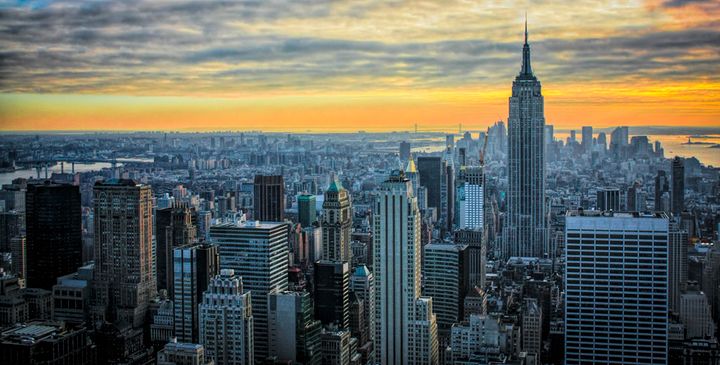
As one of the most financially powerful and economically divided cities in the nation, New York City is a microcosm of the New Urban Crisis.
For most of modern history, cities have served as vibrant centers of industry, producing the vast share of the world’s economic growth and some of its greatest cultural achievements. But in the late 1960s and 1970s, it seemed cities were bound for decline. Crime was rampant, poverty was on the rise, and middle-class residents were leaving in droves for the suburbs. By 1975, one of the most economically powerful cities in the world, New York City, was on the verge of bankruptcy.
Thankfully, cities rebounded spectacularly at the turn of the millennium as new talent, jobs, and businesses returned to their former urban homes. But with this success came a new set of deep-seated challenges, including gentrification, economic segregation, and a disappearing middle class — “The New Urban Crisis,” according to my colleague Richard Florida.
Recently, the NYUSPS Schack Institute of Real Estate Urban Lab convened a number of expert urbanists to brainstorm solutions to the New Urban Crisis. In the first panel, Errol Louis, the host of NY1's “Road to City Hall,” spoke with Richard Florida about the issues plaguing our global cities. In the second panel, Jonathan Bowles, the Executive Director at Center for an Urban Future; Robert Hammond, the Executive Director of Friends of the High Line; and Juliette Michaelson, the Executive Vice President of the Regional Plan Association discussed how the crisis has affected New York City.
A Crisis Gone Global
For many years, Richard Florida considered himself an urban optimist, believing in the transformative power of cities and their ability to bounce back in times of crisis. But today’s crisis, he says, is even deeper and more encompassing than its predecessor. While watching cities become increasingly divided between the advantaged and disadvantaged, Florida says he slowly began to witness “the ultimate contradiction of modern society.” “The message of [my] book is that these forces are really powerful and structural,” Florida says. “They are coming at us out of a cannon.”
So what can we do to stop them? Before turning to a solution, Florida argues that the creative class should not be held responsible for our current divides. While knowledge workers have certainly benefitted from the lion’s share of economic opportunity in cities, they remain essential to economic growth. Unfortunately, Florida says, inequality and segregation are inevitable byproducts of urban success, brought out by the clustering of talented people in dense urban areas.
This helps to explain why some of our largest and most prominent cities, including New York, Los Angeles, and San Francisco, suffer from the deepest divides. Los Angeles ranks first among large metros on Florida’s New Urban Crisis Index. New York ranks second, while San Francisco ranks third. In short, these cities have quickly become the epicenters of the New Urban Crisis.
While even the most progressive mayors have failed to prevent the New Urban Crisis from coming, there is plenty to be done to make cities more inclusive. To start, Florida argues, cities must commit to building more affordable housing, with a specific focus on rental housing. Cities must also strive to upgrade their low-wage service jobs to more sustainable, family-supporting work. Florida also highlights the role of public-private partnerships and community incubators in spurring better jobs and more inclusive development.
The last piece of the puzzle, he argues, is perhaps the most important. Cities must focus on improving their transit networks to accommodate outlying urban residents, as well as those in nearby suburbs. In the same way that cities subsidize roads, they must also consider subsidizing transit development. “Connecting the suburbs by transit is the only way to functionally rebuild them,” Florida says.
New York City’s Role
As one of the most financially powerful and economically divided cities in the nation, New York City is a microcosm of the New Urban Crisis. As Juliette Michaelson points out, New Yorkers suffer from some of the longest commutes, highest rents, and steepest transportation costs in the U.S. Although the city has seen significant job growth among its low-wage sector, its sky-high housing costs consume the majority of workers’ salaries. Even middle-class New Yorkers can no longer afford to live in Manhattan, and are increasingly drawn to boroughs such as Brooklyn and Queens. On the commercial side, many companies have followed workers to the city’s outer boroughs, in turn displacing longtime blue-collar and low-income residents.
According to Jonathan Bowles, education is a necessary solution to this problem. Unfortunately, because top employers in New York City know they can attract the world’s best and brightest, they often ignore local talent. As a result, many community college students are forced to drop out early due to social and economic constraints. In the future, Bowles says he would like to see major employers embrace community college students by offering additional internships and job opportunities. “A path to a middle class really runs through education,” he says.
Another way to promote inclusivity in New York is to account for all residents when designing a new development project, says Robert Hammond. As the co-founder of the High Line, Hammond says he learned this lesson after seeing the displacement of low-income New Yorkers on Manhattan’s West Side. “Once you create value, it’s very hard to take it back,” he says. Rather than revamping established programs to focus on underserved residents, Hammond says, it is easier—and more effective—to account for the public during the design stages.
But perhaps the biggest obstacle to solving New York’s urban crisis is intrinsic. According to Michaelson, eliminating the city’s economic and social divides depends on reversing decades of policy that disfavored the poor, middle, and working classes. “The lack of trust that has developed over the last 75 years is going to be difficult to overcome,” Michaelson says. “People don’t believe that change is going to benefit them.”
In New York City and across the country, building more inclusive communities starts not with new development projects or educational programs—though these are important solutions—but with regaining the trust of urban residents.
